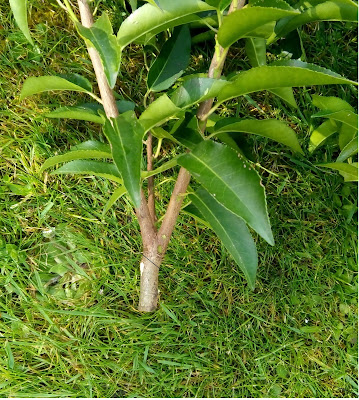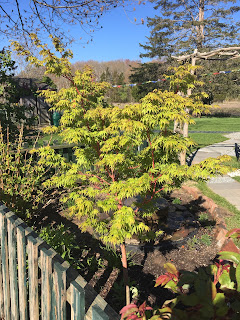Funny, having very recently written about my exploits,
tidying up a small Acer palmatum, I have now received a question from Donna in Rhode Island, asking about her rather lovely Japanese Maple, which is a bit uneven.
Donna says:
"I have a few long branches which seem to have been cut before I bought it and new, smaller branches trying to reassert themselves in the same direction trying to grow parallel with the old."
This is a very common problem: the nurseries know that people want to buy a good-sized tree (or shrub) but they don't want it so big that they can't get it in their car.
The answer, alas, is for the nursery to chop bits off, in order to keep the tree or shrub down to a manageable height, with no thought for how it is going to grow for the rest of its life.
It's very common for plants to respond to pruning by sending out a spurt or clump of new shoots from the point where they were cut: this is often an excellent thing, if you want a hedge, or if you want a multi-stemmed tree, but not so good if you are looking for a more traditional "tree" shape.
Especially for these Japanese Maples, which are supposed, if anything, to have sinuous and interesting trunks, not a stick with a tuft of foliage on top.
(I'm not saying that Donna's tree is a stick with a tuft of foliage, no sir, not at all!)
Here's a couple of photos to illustrate this phenomenon:
They are photos of a particular Portugese Laurel (Prunus lusitanica), which regularly outgrows the space in which it is planted. Every year, the owner asks me to reduce it in height, but not to remove any of the width, because it is screening something ugly. So instead of the usual "rule of three" pruning technique, I have to do what I call "lollipopping" which is where you just chop a bit off the top, to bring it down to a reasonable height.
(Not a technique I enjoy using, but in some circumstances, I do what I have to do!)
Now, every time I do this, the cut end sprouts a few new shoots. So, the next time I do it, I cut the original single branch, an inch or two lower than where I cut it last time.
Why? you ask.
Well, let's say it's Year One, and there are seven upright stems which are too tall. I cut them all - that's seven stems, all cut to say 6' high,as per the Client's request.
For the rest of the year, they grow merrily, each one putting out three or four shoots.
Now it's Year Two, and those multiple new shoots - 7 x 3 or 4 - are now too high again. If I were to cut each of them, that would leave me with up to 28 shoots, all about three inches higher than my original 6' cut.
They all grow merrily, again, each one putting out three or four shoots.
So in Year Three, oh dear, we have 28 x 3 or 4 shoots, and now our small shrub is looking rather top heavy - bare down below, and a great big tuft of foliage up the top. The over-heavy top foliage keeps the light away from the lower branches, so they tend to get less and less well clothed.
And now I have to reach up to 6'6" in order to cut them, and I'm only 5' 6" myself. (Actually, I'm five foot five and three quarters, it's my ambition to be five foot six. Apparently we stop growing upwards as we get older, and start to actually shrink. I'm not sure if I'm sufficiently aged to start shrinking - although I have felt like it in the past few months!)
So you get the point: the shrub is growing higher, and I am not. Eventually I have to start standing on steps in order to cut it each year, and the Client eventually notices that it's growing too high.
All this palaver can be avoided by simply cutting a little bit BELOW your last-year's cut.
Here's a picture of the one I did last week:
Here you can see that just above my cut, the stem branches into three.
Those are the new shoots from last season, which grew in response to me cutting it, just where the fork occurs.
If I were to cut each of them, I would have three times three shoots next year.
Aagh, panic! That would be bad.
Here's another branch from the same shrub: again, I have cut it just below my last year's cut, and you can see that this one has four big stems shooting from the cut (there's one round the back), and a couple of little ones as well.
So, getting back to Donna's question, when the nursery chop a bit off a tree or shrub, the tree often responds by throwing out several new shoots from the cut end.
Sometimes, this is a desirable thing: it's how you get multi-stemmed trees, for a start!
But in other cases, it leaves the tree - in this case - with what is called "multiple leaders", so instead of having the traditional single trunk or leader, Donna's tree is developing two or more of them, at the same time.
All is not lost: if Donna wants the tree to grow taller, in a traditional single-trunked shape, then she will have to select the smaller of the two parallel upright leaders, and cut it off.
This is to leave the tree with only one leader, so that it will concentrate on becoming a tree. Sometimes this will leave the tree horribly lop-sided, in which case the remaining stem might need a bit of a help, ie a stout cane that it can be tied to, in order to force it back into a fully upright position.
But you would be surprised how trees will straighten themselves up, if a lot of branches are removed. They are quite remarkable!
"Hang on," I hear you say, "won't that cut end sprout three or four new shoots, as you have just described?" Top marks for listening, well done. Yes, it probably will, so Donna will have to check it every couple of weeks, and gently rub off any buds that form on the cut end.
Also, if the other leader is "forced" into a fully upright position, the miracle of hormones will mean that the tree will put most of it's growing efforts into that stem, and won't send as many "grow! grow!" messages to the cut end.
But if Donna wants to keep the tree small, and to encourage it into a more Japanese frame of mind, then she can take a look at those longer, sticky-out branches, and - just as I did with the small acer in the other article - she can shorten those branches by looking underneath them, and cutting at a point where they branch.
This is so much easier to demonstrate than to describe! I have been asked many times to put up videos of How To Do Stuff, and I'm thinking about it...
So if I had Donna's tree, and here it is again:
..what would I do?
Assuming that it is planted there for beauty, and not for screening or privacy, I would leave the two parallel upright stems, but I would trim off the bits which are shooting off to the top left, and also to the top right.
This would give the tree more of a Japanese feel, being slightly more flat-topped, rather than having two horns sticking up.
I've put in some red lines to indicate roughly where I would chop - can you see them?
And when I say "chop" I don't mean, chop, of course, I mean that I would carefully clip out the unwanted stems, leaving as natural a line as possible.
Or this is the drastic version, turning it back into a single-stemmed tree.
This time my red line is very low down - ooooerrr! - and would basically remove the entire right hand side of the tree. I assume that the left-hand side is more desirable, but this is the sort of thing for which you really need to see the tree, in situ.
It might look very different from the other angle.
So there you go, Donna, I hope that helps!
Did you enjoy this article? Did you find it useful? Would you like me to answer your own, personal, gardening question? Become a Patron - just click here - and support me! Or use the Donate button for a one-off donation. If just 10% of my visitors gave me a pound a month, I'd be able to spend a lot more time answering all the questions!!




















